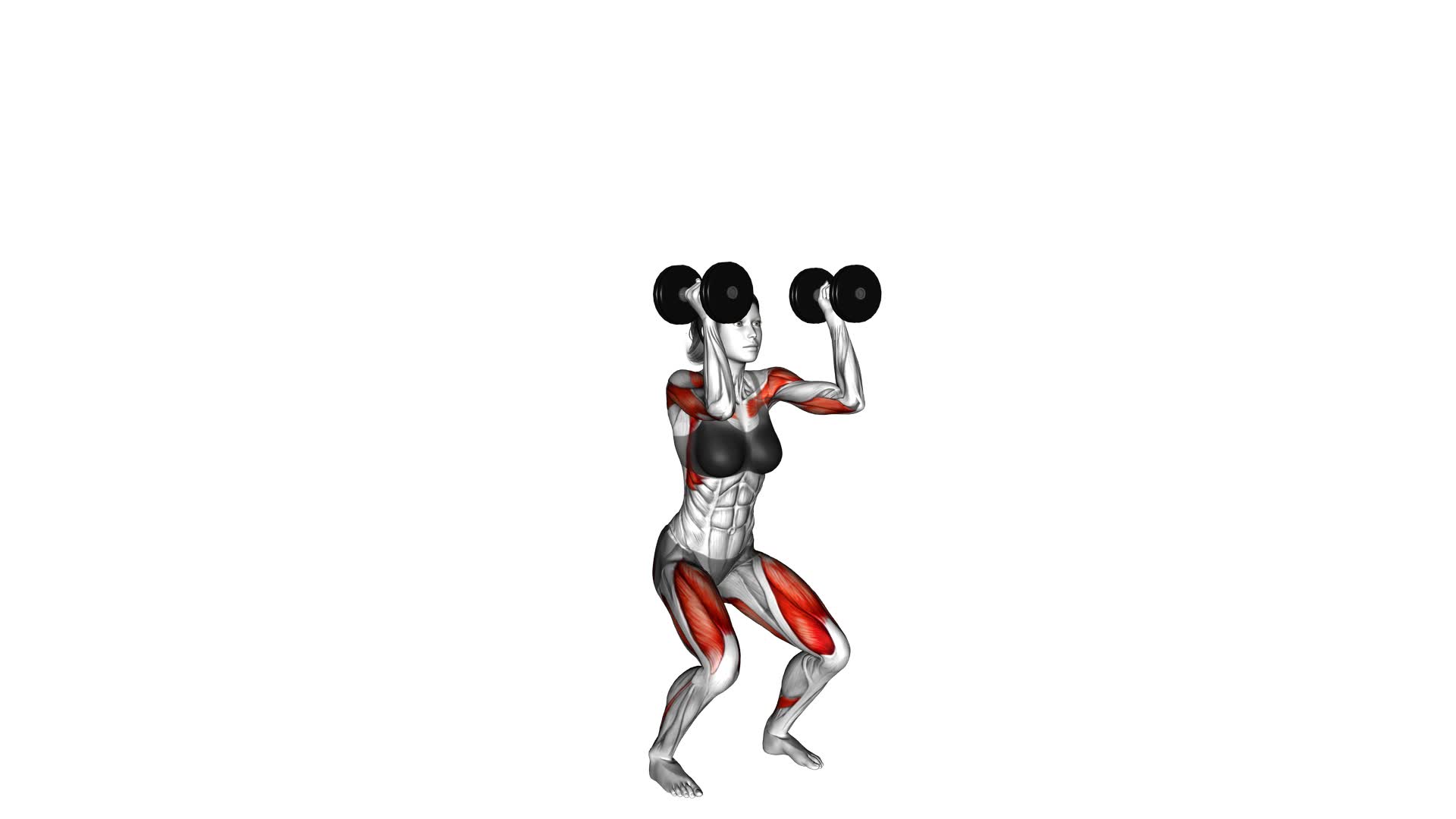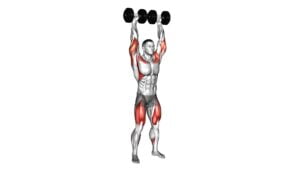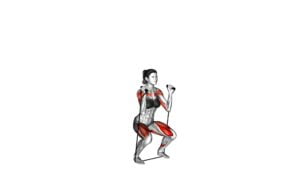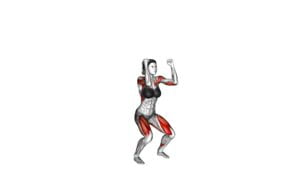Dumbbell Thruster (female) – Video Exercise Guide & Tips

Get ready to tone your muscles and boost your fitness with the dumbbell thruster! In this video exercise guide, we'll show you how to perform this challenging move with proper form and technique.
Watch This Exercise Video
Whether you're a beginner or advanced, there are variations to suit your fitness level. Avoid common mistakes and learn how to incorporate dumbbell thrusters into your workout routine for maximum results.
Let's get started and take your fitness to the next level!
Key Takeaways
- Dumbbell thrusters improve overall strength and cardiovascular endurance.
- They engage multiple muscle groups for an efficient and effective workout.
- Dumbbell thrusters enhance functional strength and reduce the risk of injury.
- Incorporating variations and modifications can help avoid plateaus in progress.
Benefits of Dumbbell Thrusters
One of the benefits of performing dumbbell thrusters is that they can help improve your overall strength and cardiovascular endurance.
Dumbbell thrusters are a compound exercise that engages multiple muscle groups, making it an efficient and effective workout choice. This exercise activates the muscles in your legs, glutes, core, shoulders, and arms, resulting in increased muscular strength and endurance.
By incorporating dumbbell thrusters into your workout routine, you can enhance your functional strength, making everyday activities easier and reducing the risk of injury. Additionally, the combination of upper and lower body movements in this exercise helps to elevate your heart rate, providing a cardiovascular challenge. This can improve your endurance and stamina over time.
The benefits of compound exercises like dumbbell thrusters extend beyond just strength and cardiovascular improvements. They also promote coordination, stability, and balance, as you need to maintain control and stability throughout the movement. By incorporating dumbbell thrusters into your workouts, you can enjoy these benefits and take your fitness to the next level.
Now, let's move on to discussing the proper form and technique for performing dumbbell thrusters.
Proper Form and Technique
To perform dumbbell thrusters with proper form and technique, you need to ensure that you maintain control and stability throughout the movement. Here are three key elements to focus on:
- Squatting:
Begin by standing with your feet shoulder-width apart, holding the dumbbells at shoulder height with your palms facing inward. Lower your body into a squat position, keeping your chest up and your knees in line with your toes. Make sure to maintain a neutral spine throughout the movement.
- Pressing:
As you stand up from the squat, press the dumbbells overhead, fully extending your arms. Keep your core engaged and avoid arching your back. This will engage your shoulders, triceps, and upper back.
- Breathing:
Remember to breathe throughout the exercise. Inhale as you lower into the squat and exhale as you press the dumbbells overhead. This will help you maintain control and stability.
Now, let's address some common errors to watch out for. One mistake is using weights that are too heavy. Start with lighter dumbbells and gradually increase the weight as your strength improves. Also, avoid rushing the movement and sacrificing proper form for speed. Take your time to perform each repetition correctly.
Variations for Different Fitness Levels
Now let's talk about how you can modify the dumbbell thruster based on your fitness level.
If you're a beginner, there are modifications available to help you ease into the exercise and build strength gradually.
On the other hand, if you're an advanced athlete looking for a challenge, there are adaptations that can make the dumbbell thruster more intense and demanding.
Beginner Modifications Available
Start with lighter dumbbells to modify the dumbbell thruster exercise for beginners. Here are three beginner modifications that can be used to progress or regress the exercise:
- Goblet Squat: Hold a dumbbell vertically against your chest with both hands, and perform a squat. This modification helps build strength and stability in the lower body.
- Split Squat Thruster: Start in a split squat position with one foot forward and the other foot back. Hold dumbbells at shoulder height and perform a squat, alternating legs. This modification adds an element of balance and coordination.
- Dumbbell Front Raise to Overhead Press: Stand with your feet shoulder-width apart, holding dumbbells in front of your thighs. Raise the dumbbells to shoulder height, then press them overhead. This modification focuses on shoulder strength and stability.
Remember to choose a modification that matches your fitness level and gradually progress as you become more comfortable and confident with the exercise.
Advanced Adaptations for Athletes
Take your dumbbell thruster to the next level with these advanced adaptations for athletes.
If you're looking to challenge yourself and push your limits, try incorporating advanced modifications and techniques into your dumbbell thruster routine.
One advanced modification you can try is increasing the weight of the dumbbells. By using heavier weights, you'll engage more muscle groups and build strength and power.
Another advanced technique is to add a jump at the top of the thruster movement. This explosive movement will enhance your explosive power and improve your overall athletic performance.
Additionally, you can incorporate single-arm dumbbell thrusters to further challenge your stability and core strength.
Remember to always maintain proper form and listen to your body to prevent injury.
Common Mistakes to Avoid
To avoid common mistakes during the dumbbell thruster exercise, focus on maintaining proper form and technique. Here are three technique tips to help you perform the exercise correctly and avoid potential errors:
- Squat Depth: One common mistake isn't squatting deep enough. Ensure that you lower your hips below parallel, aiming for a 90-degree bend in your knees. This will engage your glutes and quads effectively and prevent strain on your knees.
- Elbow Position: Another mistake is allowing your elbows to drop during the exercise. Keep your elbows up and in line with your shoulders throughout the movement. This will help maintain stability and prevent unnecessary stress on your wrists and shoulders.
- Breathing Pattern: Many people forget to breathe properly during the dumbbell thruster. Remember to exhale as you push the dumbbells overhead and inhale as you lower them back down. This controlled breathing will provide stability and energy throughout the exercise.
Incorporating Dumbbell Thrusters Into Your Workout Routine
If you're looking to add a challenging and effective exercise to your workout routine, incorporating dumbbell thrusters is a great option. These compound movements offer numerous benefits, including improved strength, endurance, and coordination.
Additionally, there are variations and modifications available to suit different fitness levels and goals.
Benefits of Thrusters
You can incorporate dumbbell thrusters into your workout routine to experience the numerous benefits they offer. Here are three reasons why you should consider adding them to your exercise regimen:
- Full-body workout: Dumbbell thrusters are compound exercises that engage multiple muscle groups simultaneously. By combining a front squat with an overhead press, they target your legs, glutes, core, shoulders, and arms. This means you can maximize your workout efficiency and save time.
- Increased intensity: If you're looking to amp up the intensity of your workouts, dumbbell thrusters are an excellent choice. By incorporating weights into the exercise, you add resistance, which challenges your muscles and helps build strength and endurance.
- Functional movement: Dumbbell thrusters mimic movements we use in everyday activities, such as lifting objects or reaching overhead. By practicing these functional movements, you can improve your overall strength and coordination, making your daily tasks easier to perform.
Incorporating dumbbell thrusters into your workout routine can provide a range of benefits, from a full-body workout to increased intensity and improved functional movements. So why not give them a try and see the positive impact they can have on your fitness journey?
Variations and Modifications
To incorporate dumbbell thrusters into your workout routine and add variety, there are several variations and modifications you can try.
- One variation is the single-arm dumbbell thruster, where you hold a dumbbell in one hand and perform the exercise on each side. This adds an extra challenge to your core stability and balance.
- Another variation is the dumbbell front squat thruster, where you start with a front squat and then transition into the thruster movement. This targets your quadriceps and glutes even more.
- Additionally, you can modify the exercise by using different weights or changing the tempo of the movement.
Experimenting with these variations and modifications will keep your workouts fresh and help you avoid plateaus.
Now, let's move on to some tips for maximizing your results.
Tips for Maximizing Results
To maximize your results with the dumbbell thruster exercise, focus on maintaining proper form throughout the movement. This will help you maximize efficiency and avoid plateaus in your progress.
Here are three tips to help you get the most out of your dumbbell thruster workout:
- Engage your core: As you perform the thruster, remember to tighten your abdominal muscles. This won't only help stabilize your body during the movement but also ensure that you're working your core muscles effectively.
- Control your breathing: Proper breathing technique is crucial for maximizing your results. Inhale as you lower into the squat position, and exhale forcefully as you drive through your legs to press the dumbbells overhead. This coordinated breathing will help you generate more power and maintain stability throughout the exercise.
- Gradually increase weight: To avoid plateaus and continue making progress, gradually increase the weight of the dumbbells over time. This will challenge your muscles and keep them adapting to new stimuli, leading to continued growth and improvement.
By following these tips and maintaining proper form, you can maximize the efficiency of your dumbbell thruster workouts and avoid hitting a plateau in your progress.
Keep pushing yourself and enjoy the benefits of this effective exercise.
Frequently Asked Questions
How Much Weight Should I Use for Dumbbell Thrusters?
To determine how much weight to use for dumbbell thrusters, start by focusing on proper form. This exercise involves a squat combined with an overhead press, so choose a weight that challenges you but still allows you to maintain proper technique throughout the movement.
If you're new to this exercise, it's a good idea to start with lighter weights and gradually increase the load as you become more comfortable and confident.
Can Dumbbell Thrusters Help Me Lose Weight?
Dumbbell thrusters can definitely help you lose weight. Incorporating them into your weight loss routine has many benefits.
Not only do they target multiple muscle groups, but they also increase your heart rate, leading to more calorie burn.
To maximize the calorie burn with dumbbell thrusters, focus on performing them with proper form and intensity.
Combine them with a balanced diet and other exercises for optimal weight loss results.
Are Dumbbell Thrusters Suitable for Beginners?
Dumbbell thrusters can be suitable for beginners. They offer a versatile full-body workout that can be modified to match your fitness level. By adjusting the weight and depth of the squat, you can gradually build strength and endurance.
Dumbbell thrusters engage multiple muscle groups, including the legs, core, and shoulders, making them an effective exercise for overall fitness. Start with lighter weights and focus on proper form to avoid injury and maximize the benefits of this exercise.
How Many Reps and Sets Should I Do for Dumbbell Thrusters?
To determine how many reps and sets you should do for dumbbell thrusters, it's important to consider your fitness level and goals.
Beginners can start with 2-3 sets of 8-10 reps, gradually increasing as you get stronger.
Intermediate and advanced individuals can aim for 3-4 sets of 12-15 reps.
Remember to modify the exercise based on your fitness level, and avoid common mistakes like using improper form or lifting too heavy of a weight.
Can Dumbbell Thrusters Help Improve My Cardiovascular Fitness?
Dumbbell thrusters can indeed help improve your cardiovascular fitness. They're a compound exercise that engages multiple muscle groups and elevates your heart rate.
If you're looking for alternatives, other exercises like burpees, jumping jacks, or mountain climbers can also be effective.
However, incorporating dumbbell thrusters into a HIIT workout routine offers additional benefits. It can enhance your strength, endurance, and overall conditioning, making it a great addition to your fitness regimen.
Conclusion
In conclusion, dumbbell thrusters are an effective full-body exercise that can provide numerous benefits. These benefits include increased strength, endurance, and calorie burn.
By maintaining proper form and technique, individuals can avoid common mistakes and maximize their results.
With variations available for different fitness levels, anyone can incorporate dumbbell thrusters into their workout routine.
Remember to start with a weight that challenges you but allows for proper execution.
Keep pushing yourself and enjoy the benefits of this versatile exercise.

Author
Years ago, the spark of my life’s passion ignited in my mind the moment I stepped into the local gym for the first time. The inaugural bead of perspiration, the initial endeavor, the very first surge of endorphins, and a sense of pride that washed over me post-workout marked the beginning of my deep-seated interest in strength sports, fitness, and sports nutrition. This very curiosity blossomed rapidly into a profound fascination, propelling me to earn a Master’s degree in Physical Education from the Academy of Physical Education in Krakow, followed by a Sports Manager diploma from the Jagiellonian University. My journey of growth led me to gain more specialized qualifications, such as being a certified personal trainer with a focus on sports dietetics, a lifeguard, and an instructor for wellness and corrective gymnastics. Theoretical knowledge paired seamlessly with practical experience, reinforcing my belief that the transformation of individuals under my guidance was also a reflection of my personal growth. This belief holds true even today. Each day, I strive to push the boundaries and explore new realms. These realms gently elevate me to greater heights. The unique combination of passion for my field and the continuous quest for growth fuels my drive to break new ground.







